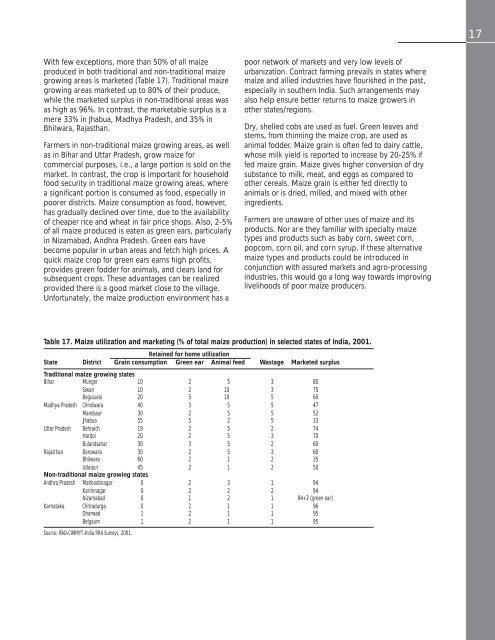Maize in India: Production Systems, Constraints - AgEcon Search
Maize in India: Production Systems, Constraints - AgEcon Search
Maize in India: Production Systems, Constraints - AgEcon Search
Create successful ePaper yourself
Turn your PDF publications into a flip-book with our unique Google optimized e-Paper software.
17<br />
With few exceptions, more than 50% of all maize<br />
produced <strong>in</strong> both traditional and non-traditional maize<br />
grow<strong>in</strong>g areas is marketed (Table 17). Traditional maize<br />
grow<strong>in</strong>g areas marketed up to 80% of their produce,<br />
while the marketed surplus <strong>in</strong> non-traditional areas was<br />
as high as 96%. In contrast, the marketable surplus is a<br />
mere 33% <strong>in</strong> Jhabua, Madhya Pradesh, and 35% <strong>in</strong><br />
Bhilwara, Rajasthan.<br />
Farmers <strong>in</strong> non-traditional maize grow<strong>in</strong>g areas, as well<br />
as <strong>in</strong> Bihar and Uttar Pradesh, grow maize for<br />
commercial purposes, i.e., a large portion is sold on the<br />
market. In contrast, the crop is important for household<br />
food security <strong>in</strong> traditional maize grow<strong>in</strong>g areas, where<br />
a significant portion is consumed as food, especially <strong>in</strong><br />
poorer districts. <strong>Maize</strong> consumption as food, however,<br />
has gradually decl<strong>in</strong>ed over time, due to the availability<br />
of cheaper rice and wheat <strong>in</strong> fair price shops. Also, 2-5%<br />
of all maize produced is eaten as green ears, particularly<br />
<strong>in</strong> Nizamabad, Andhra Pradesh. Green ears have<br />
become popular <strong>in</strong> urban areas and fetch high prices. A<br />
quick maize crop for green ears earns high profits,<br />
provides green fodder for animals, and clears land for<br />
subsequent crops. These advantages can be realized<br />
provided there is a good market close to the village.<br />
Unfortunately, the maize production environment has a<br />
poor network of markets and very low levels of<br />
urbanization. Contract farm<strong>in</strong>g prevails <strong>in</strong> states where<br />
maize and allied <strong>in</strong>dustries have flourished <strong>in</strong> the past,<br />
especially <strong>in</strong> southern <strong>India</strong>. Such arrangements may<br />
also help ensure better returns to maize growers <strong>in</strong><br />
other states/regions.<br />
Dry, shelled cobs are used as fuel. Green leaves and<br />
stems, from th<strong>in</strong>n<strong>in</strong>g the maize crop, are used as<br />
animal fodder. <strong>Maize</strong> gra<strong>in</strong> is often fed to dairy cattle,<br />
whose milk yield is reported to <strong>in</strong>crease by 20-25% if<br />
fed maize gra<strong>in</strong>. <strong>Maize</strong> gives higher conversion of dry<br />
substance to milk, meat, and eggs as compared to<br />
other cereals. <strong>Maize</strong> gra<strong>in</strong> is either fed directly to<br />
animals or is dried, milled, and mixed with other<br />
<strong>in</strong>gredients.<br />
Farmers are unaware of other uses of maize and its<br />
products. Nor ar e they familiar with specialty maize<br />
types and products such as baby corn, sweet corn,<br />
popcorn, corn oil, and corn syrup. If these alternative<br />
maize types and products could be <strong>in</strong>troduced <strong>in</strong><br />
conjunction with assured markets and agro-process<strong>in</strong>g<br />
<strong>in</strong>dustries, this would go a long way towards improv<strong>in</strong>g<br />
livelihoods of poor maize producers.<br />
Table 17. <strong>Maize</strong> utilization and market<strong>in</strong>g (% of total maize production) <strong>in</strong> selected states of <strong>India</strong>, 2001.<br />
Reta<strong>in</strong>ed for home utilization<br />
State District Gra<strong>in</strong> consumption Green ear Animal feed Wastage Marketed surplus<br />
Traditional maize grow<strong>in</strong>g states<br />
Bihar Munger 10 2 5 3 80<br />
Siwan 10 2 10 3 75<br />
Begusarai 20 5 10 5 60<br />
Madhya Pradesh Ch<strong>in</strong>dwara 40 3 5 5 47<br />
Mandsaur 30 2 5 5 52<br />
Jhabua 55 5 2 5 33<br />
Uttar Pradesh Behraich 19 2 5 2 74<br />
Hardoi 20 2 5 3 70<br />
Bulandsahar 30 3 5 2 60<br />
Rajasthan Banswara 30 2 5 3 60<br />
Bhilwara 60 2 1 2 35<br />
Udaipur 45 2 1 2 50<br />
Non-traditional maize grow<strong>in</strong>g states<br />
Andhra Pradesh Mahboobnagar 0 2 3 1 94<br />
Karimnagar 0 2 2 2 94<br />
Nizamabad 0 1 2 1 94+2 (green ear)<br />
Karnataka Chitradurga 0 2 1 1 96<br />
Dharwad 1 2 1 1 95<br />
Belgaum 1 2 1 1 95<br />
Source: IFAD-CIMMYT-<strong>India</strong> RRA Surveys, 2001.

















